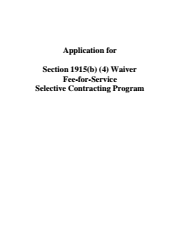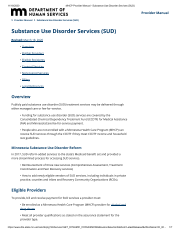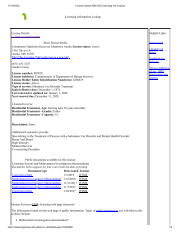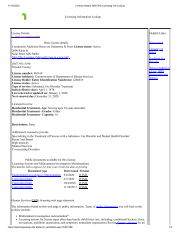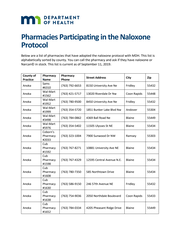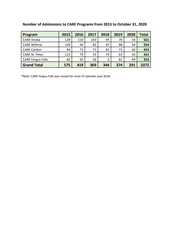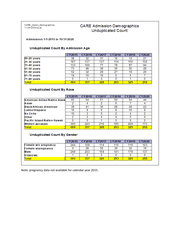Minnesota Civil Commitment
| Submitted | Oct. 26, 2020 |
MuckRock users can file, duplicate, track, and share public records requests like this one. Learn more.
Communications
From: HIJ Action Lab
To Whom It May Concern:
The Health in Justice Action Lab at Northeastern University is interested in Minnesota’s civil commitment programs under the Minnesota Commitment and Treatment Act (Minn. Stat. § 253B.09). Specifically, we are looking for data concerning individuals civilly committed for substance use and addiction treatment, the programmatic offerings for those individuals, and Minnesota’s response to COVID-19 in its civil commitment system.
In order to permit the public to understand how the state of Minnesota is administering involuntary commitment, the outcomes of that program, and the impact on Minnesota’s public health, the Health in Justice Action Lab is making this request pursuant to Minn. Stat. §13.03 for the following records:
1. State-wide volume. Any record showing the number of people who were civilly committed for substance use and addiction in each year since 2015 to the latest available.
2. Demographic information. Any and all records reflecting de-identified demographic summary statistics, including (but not necessarily limited to) race, gender, age, and pregnancy status, pertaining to individuals who have been civilly committed for substance use and addiction, from 2015 to latest available.
3. Facility information. Summary statistics, reports, or relevant documentation detailing facilities that are used to house people civilly commitment for substance use and addiction, including the following information:
a) Summary of the number of individuals committed to each individual facility for substance use in each year since 2015, to latest available.
b) For each facility housing people civilly committed for substance use, summary of the number of individuals also being held on criminal charges in those same facilities
c) Which facilities employ or contract health care providers licensed to prescribe methadone and/or buprenorphine.
d) Number of individuals each facility is licensed to house.
e) State agency managing each facility housing people civilly committed for substance use disorder.
f) Any and all documentation noting the number of non-fatal and fatal overdose incidents within each facility housing people civilly committed for substance use disorder in each year since 2015.
4. Financial information. Summary statistics, reports, or relevant documentation regarding government resources or insurance funds that are used to pay for civil commitment for substance use/addiction in each year since 2015.
5. Re-entry planning. Any and all documentation regarding the re-entry planning process for people discharged from civil commitment for substance use disorder, including:
a) Overdose education and naloxone distribution
b) Linkage to treatment in the community
c) Linkage to housing in the community
d) Insurance assistance
e) Any other support or health services
6. External overdose data. Any and all documentation noting the number of overdose incidents of patients within 1 year of re-entry from civil commitment for substance use disorder/addiction in each year since 2015.
Because this request involves a matter of public concern and because it is made on behalf of a nonprofit organization, we ask that you waive any fees. If you decide not to waive fees, we request that you permit us to examine, at our election, the responsive documents before deciding which portions to transmit. We prefer the documents in electronic format.
Should you determine that some portion of the documents requested are exempt from disclosure, please release any reasonably segregable portions that are not exempt. In addition, please note the applicable statutory exemption and explain why it applies to the redacted portions. As you know, a custodian of public records shall comply with a request within 10 business days after receipt.
Thank you for your assistance. We look forward to your response.
Sincerely,
Louis Miyara
Health in Justice Action Lab
Northeastern University
From: Department of Human Services
Mr. Miyara,
I am writing to let you know that DHS has received your below request for public data and is in the process of identifying what responsive data it may have. If there will be a cost to produce data, I will reach out to you again.
I want to clarify that under Minnesota law, there is no specified number of days in which a state agency must respond to this type of request. Only requests made by a data subject for data about themselves is subject to the 10 day requirement found in Minn. Stat. 13.04. DHS will of course strive to provide any responsive data as promptly as it can.
Thanks,
Kelli
Kelli Lassig, JD, CHC
Associate General Counsel | General Counsel’s Office
Minnesota Department of Human Services
O: 651-431-3689
C: 651-248-1907
Kelli.A.Lassig@state.mn.us<mailto:Kelli.A.Lassig@state.mn.us>
From: Muckrock Staff
To Whom It May Concern:
I wanted to follow up on the following Minnesota Government Data Practices Act request, copied below, and originally submitted on Oct. 26, 2020. Please let me know when I can expect to receive a response.
Thanks for your help, and let me know if further clarification is needed.
From: Department of Human Services
Good Morning,
As indicted below, DHS will comply with this request as promptly as it is able. The Department expects to produce some of the data this week, with the remainder of the data to follow in another week or two.
Thanks,
Kelli
Kelli Lassig, JD, CHC
Associate General Counsel | General Counsel’s Office
Minnesota Department of Human Services
O: 651-431-3689
C: 651-248-1907
Kelli.A.Lassig@state.mn.us<mailto:Kelli.A.Lassig@state.mn.us>
-

~WRD000
From: Department of Human Services
Please see below and attached for responses to some of the data you have requested. Additional data will be forthcoming.
---
On Oct. 26, 2020:
Subject: Minnesota Government Data Practices Act Request: Minnesota Civil Commitment
To Whom It May Concern:
The Health in Justice Action Lab at Northeastern University is interested in Minnesota’s civil commitment programs under the Minnesota Commitment and Treatment Act (Minn. Stat. § 253B.09). Specifically, we are looking for data concerning individuals civilly committed for substance use and addiction treatment, the programmatic offerings for those individuals, and Minnesota’s response to COVID-19 in its civil commitment system.
In order to permit the public to understand how the state of Minnesota is administering involuntary commitment, the outcomes of that program, and the impact on Minnesota’s public health, the Health in Justice Action Lab is making this request pursuant to Minn. Stat. §13.03 for the following records:
1. State-wide volume. Any record showing the number of people who were civilly committed for substance use and addiction in each year since 2015 to the latest available.
Response: Please see attached spreadsheet.
2. Demographic information. Any and all records reflecting de-identified demographic summary statistics, including (but not necessarily limited to) race, gender, age, and pregnancy status, pertaining to individuals who have been civilly committed for substance use and addiction, from 2015 to latest available
Response: DHS does not have access to demographic information for all individuals civilly committed for substance use treatment (referred to in Minnesota law as civil commitment as chemically dependent), as not all such individuals are committed to DHS or referred for placement in DHS programs. The Minnesota Judicial Branch may have responsive data. DHS is still searching for responsive data for the five state operated facilities treating CD civilly committed individuals.
3. Facility information. Summary statistics, reports, or relevant documentation detailing facilities that are used to house people civilly commitment for substance use and addiction, including the following information:
Response: The State of Minnesota operates five substance abuse treatment programs that serve individuals civilly committed as chemically dependent under Minn. Stat. 253B. As noted above, not all individuals civilly committed as chemically dependent are committed to or served by state operated programs, many or most are served by private providers. The state operated facilities are as follows:
Community Addiction Recovery Enterprise (CARE)-Anoka
CARE-Carlton
CARE-Fergus Falls
CARE-St. Peter
CARE-Willmar
Attached is the licensing data available for each of these programs. Additional general information about the CARE programs can be found on the DHS public website, at the below link:
a) Summary of the number of individuals committed to each individual facility for substance use in each year since 2015, to latest available.
Response: Under Minnesota law, when an individual is committed to DHS, they are not committed to a specific DHS facility, but to the agency itself. Clinical staff within DHS then make placement decisions based on a variety of factors. Additionally, as previously mentioned, not all civil commitments are to DHS nor are all committed individuals served in DHS operated programs. Responsive data for the DHS operated facilities listed above is still being gathered.
b) For each facility housing people civilly committed for substance use, summary of the number of individuals also being held on criminal charges in those same facilities
Response: DHS does not detain clients based on criminal charges in its CARE programs. DHS’s authority to hold involuntary clients is found in civil law, specifically Minn. Stat. 253B.
c) Which facilities employ or contract health care providers licensed to prescribe methadone and/or buprenorphine.
d) Number of individuals each facility is licensed to house.
Response: Each of the above named CARE programs is licensed to served up to 16 clients.
e) State agency managing each facility housing people civilly committed for substance use disorder.
Response: All state-operated CARE programs are operated by the MN Department of Human Services. However, many civilly committed individuals are not committed to DHS or referred to DHS programs for admission.
f) Any and all documentation noting the number of non-fatal and fatal overdose incidents within each facility housing people civilly committed for substance use disorder in each year since 2015.
4. Financial information. Summary statistics, reports, or relevant documentation regarding government resources or insurance funds that are used to pay for civil commitment for substance use/addiction in each year since 2015.
Response: The Consolidated Chemical Dependency Treatment Fund (CCDTF) is used to fund the treatment for some individuals civilly committed as chemically dependent in Minnesota, as is private health insurance. Please see Minn. Stat. 254B and Minn. R. 9530.
Attached are the DHS published Provider Manual for Substance Use Disorder Services funding and the State of Minnesota’s 2020 CCDTF funding application.
5. Re-entry planning. Any and all documentation regarding the re-entry planning process for people discharged from civil commitment for substance use disorder, including:
a) Overdose education and naloxone distribution
b) Linkage to treatment in the community
c) Linkage to housing in the community
d) Insurance assistance
e) Any other support or health services
6. External overdose data. Any and all documentation noting the number of overdose incidents of patients within 1 year of re-entry from civil commitment for substance use disorder/addiction in each year since 2015.
Because this request involves a matter of public concern and because it is made on behalf of a nonprofit organization, we ask that you waive any fees. If you decide not to waive fees, we request that you permit us to examine, at our election, the responsive documents before deciding which portions to transmit. We prefer the documents in electronic format.
Should you determine that some portion of the documents requested are exempt from disclosure, please release any reasonably segregable portions that are not exempt. In addition, please note the applicable statutory exemption and explain why it applies to the redacted portions. As you know, a custodian of public records shall comply with a request within 10 business days after receipt.
Thank you for your assistance. We look forward to your response.
Sincerely,
Louis Miyara
Health in Justice Action Lab
Northeastern University
Filed via MuckRock.com
E-mail (Preferred): requests@muckrock.com
Upload documents directly: https://www.muckrock.com/
Is this email coming to the wrong contact? Something else wrong? Use the above link to let us know.
For mailed responses, please address (see note):
MuckRock News
DEPT MR 104270
411A Highland Ave
Somerville, MA 02144-2516
PLEASE NOTE: This request is not filed by a MuckRock staff member, but is being sent through MuckRock by the above in order to better track, share, and manage public records requests. Also note that improperly addressed (i.e., with the requester's name rather than "MuckRock News" and the department number) requests might be returned as undeliverable.
[Image removed by sender.]
Caution: This e-mail and attached documents, if any, may contain information that is protected by state or federal law. E-mail containing private or protected information should not be sent over a public (nonsecure) Internet unless it is encrypted pursuant to DHS standards. This e-mail should be forwarded only on a strictly need-to-know basis. If you are not the intended recipient, please: (1) notify the sender immediately, (2) do not forward the message, (3) do not print the message and (4) erase the message from your system.
From: Department of Human Services
Please see below and attached for the remaining responsive data held by DHS. This completes DHS’ response to this request. Thank you.
---
On Oct. 26, 2020:
Subject: Minnesota Government Data Practices Act Request: Minnesota Civil Commitment
To Whom It May Concern:
The Health in Justice Action Lab at Northeastern University is interested in Minnesota’s civil commitment programs under the Minnesota Commitment and Treatment Act (Minn. Stat. § 253B.09). Specifically, we are looking for data concerning individuals civilly committed for substance use and addiction treatment, the programmatic offerings for those individuals, and Minnesota’s response to COVID-19 in its civil commitment system.
In order to permit the public to understand how the state of Minnesota is administering involuntary commitment, the outcomes of that program, and the impact on Minnesota’s public health, the Health in Justice Action Lab is making this request pursuant to Minn. Stat. §13.03 for the following records:
1. State-wide volume. Any record showing the number of people who were civilly committed for substance use and addiction in each year since 2015 to the latest available.
2. Demographic information. Any and all records reflecting de-identified demographic summary statistics, including (but not necessarily limited to) race, gender, age, and pregnancy status, pertaining to individuals who have been civilly committed for substance use and addiction, from 2015 to latest available.
Response: As previously noted, DHS does not have access to demographic information for all individuals civilly committed for substance use treatment (referred to in Minnesota law as civil commitment as chemically dependent), as not all such individuals are committed to DHS or referred for placement in DHS programs. The Minnesota Judicial Branch may have responsive data. Please see attachment entitled CARE Demographic Data for demographic information on CD civilly committed individuals served in the DHS operated CARE programs.
3. Facility information. Summary statistics, reports, or relevant documentation detailing facilities that are used to house people civilly commitment for substance use and addiction, including the following information:
a) Summary of the number of individuals committed to each individual facility for substance use in each year since 2015, to latest available.
Response: As previously noted, under Minnesota law, when an individual is committed to DHS, they are not committed to a specific DHS facility, but to the agency itself. Clinical staff within DHS then make placement decisions based on a variety of factors. Additionally, not all civil commitments are to DHS nor are all committed individuals served in DHS operated programs. See attachment entitled Number of Admissions to CARE Programs for responsive data.
b) For each facility housing people civilly committed for substance use, summary of the number of individuals also being held on criminal charges in those same facilities
c) Which facilities employ or contract health care providers licensed to prescribe methadone and/or buprenorphine.
Response: None of the DHS operated CARE programs currently employ or employ via contract a provider licensed to prescribe methadone and/or buprenorphine. CARE Fergus Falls, CARE St. Peter, and CARE Willmar utilize a provider employed by DHS Direct Care & Treatment at the divisional level to prescribe buprenorphine.
d) Number of individuals each facility is licensed to house.
e) State agency managing each facility housing people civilly committed for substance use disorder.
f) Any and all documentation noting the number of non-fatal and fatal overdose incidents within each facility housing people civilly committed for substance use disorder in each year since 2015.
Response: DHS classifies this as identifying data at the individual program level and therefore non-public. For that reason, DHS can only provide summary data for all CARE sites combined (CARE Anoka, CARE Carlton, CARE Fergus Falls, CARE St. Peter, CARE Willmar).
2015: 1 overdose leading to serious harm; 1 overdose leading to death
2016: 1 overdose leading to death
2017: 0
2018: 1 overdose leading to serious harm
2019: 0
2020 (to October 31): 0
4. Financial information. Summary statistics, reports, or relevant documentation regarding government resources or insurance funds that are used to pay for civil commitment for substance use/addiction in each year since 2015.
5. Re-entry planning. Any and all documentation regarding the re-entry planning process for people discharged from civil commitment for substance use disorder, including:
a) Overdose education and naloxone distribution
b) Linkage to treatment in the community
c) Linkage to housing in the community
d) Insurance assistance
e) Any other support or health services
Response: Please see attached materials.
6. External overdose data. Any and all documentation noting the number of overdose incidents of patients within 1 year of re-entry from civil commitment for substance use disorder/addiction in each year since 2015.
Response: Individuals civilly committed in Minnesota as chemically dependent are committed for an initial period of up to 6 months. That commitment can be extended by a court for up to 12 additional months (for a total of up to 18 months). Civilly committed individuals do not spend the entirety of their time under commitment in a facility. Rather, they receive treatment and are then provisionally discharged (a process laid out in Minn. Stat. 253B.15) to the community or another setting. Under Minnesota law, while on provisional discharge, committed persons are subject to the supervision of their county human services agency, not DHS. For this reason, DHS does not maintain or have access to data that would show the total number of overdose incidents following either provisional discharge or the termination of civil commitment.
Further, the state operated CARE programs would not necessarily be notified of overdoses leading to serious significant harm or death in the community after more than 72 hours from discharge (based on Joint Commission standards), and therefore DHS does not have responsive data tracked beyond this timeframe. Below are the overdoses reported to CARE programs as having occurred within 72 hours of discharge from a CARE facility.
DHS classifies this as identifying data at the individual program level and therefore non-public. For that reason, DHS can only provide summary data for all CARE sites combined (CARE Anoka, CARE Carlton, CARE Fergus Falls, CARE St. Peter, CARE Willmar).
2015: 0
2016: 0
2017: 0
2018: 1 overdose leading to death
2019: 3 overdoses leading to death
2020 (to October 31): 1 overdose leading to death
Because this request involves a matter of public concern and because it is made on behalf of a nonprofit organization, we ask that you waive any fees. If you decide not to waive fees, we request that you permit us to examine, at our election, the responsive documents before deciding which portions to transmit. We prefer the documents in electronic format.
Should you determine that some portion of the documents requested are exempt from disclosure, please release any reasonably segregable portions that are not exempt. In addition, please note the applicable statutory exemption and explain why it applies to the redacted portions. As you know, a custodian of public records shall comply with a request within 10 business days after receipt.
Thank you for your assistance. We look forward to your response.
Sincerely,
Louis Miyara
Health in Justice Action Lab
Northeastern University
Filed via MuckRock.com
E-mail (Preferred): requests@muckrock.com<mailto:requests@muckrock.com>
Upload documents directly: https://www.muckrock.com/
Is this email coming to the wrong contact? Something else wrong? Use the above link to let us know.
For mailed responses, please address (see note):
MuckRock News
DEPT MR 104270
411A Highland Ave
Somerville, MA 02144-2516
PLEASE NOTE: This request is not filed by a MuckRock staff member, but is being sent through MuckRock by the above in order to better track, share, and manage public records requests. Also note that improperly addressed (i.e., with the requester's name rather than "MuckRock News" and the department number) requests might be returned as undeliverable.
[Image removed by sender.]
Caution: This e-mail and attached documents, if any, may contain information that is protected by state or federal law. E-mail containing private or protected information should not be sent over a public (nonsecure) Internet unless it is encrypted pursuant to DHS standards. This e-mail should be forwarded only on a strictly need-to-know basis. If you are not the intended recipient, please: (1) notify the sender immediately, (2) do not forward the message, (3) do not print the message and (4) erase the message from your system.
-

image001
From: HIJ Action Lab
Hi,
Thanks so much for your help with this request! I really appreciate it.
Sincerely,
Louis Miyara
Files
pages
